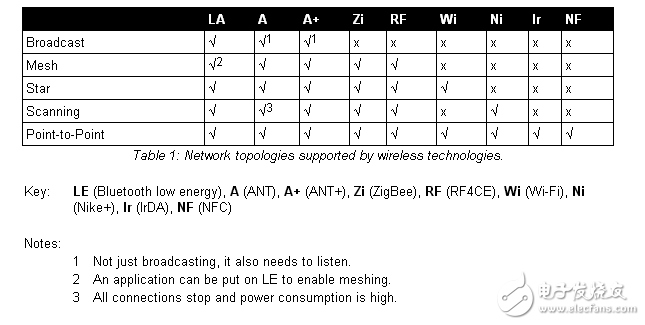
资料下载

低功耗无线技术比较
低功耗无线技术比较
这篇文章比较了蓝牙低能量,蚂蚁,蚂蚁+,ZigBee,ZigBee RF4CE,Wi-Fi,耐克+,IrDA,和近场通信(NFC)标准,细化的特点,利益,和在各种应用中,每个协议的不足之处。
随着超低功耗无线芯片组的引入,许多创新性的新应用正在成为可能。直到最近,在传感器和客户端之间实现数据传输的唯一方法是使用电线,或者手动从日志设备收集数据。无线技术已经几十年了。然而,他们倾向于使用大量的电力,需要专门的设备来建立通信。
大多数目标市场的特点是在传感器节点和中心设备之间周期性地传递少量传感器信息。一些确定的最终产品,可能实现低功耗无线电系统包括手机,健康和健身设备,家庭自动化,供暖,通风,空调(HVAC),遥控器,游戏,人机接口设备(HID),智能仪表,付款,和许多其他。

These applications are all constrained by the following critical key requirements: ultra-low-power, low cost, and physical size.
The ultra-low-power requirement is mainly due to the need of targeted devices to operate for extended periods of time from coin cells or energy scavenger technology. Apart from the obvious advantages of a low chipset cost, overall product expense is largely affected by the power source. For example, if a shopping mall has a wireless beacon in every shop and batteries need replacing regularly, the maintenance cost will soon outweigh the advantages of such a technology being deployed.
This article analyzes the pros and cons of various low-power wireless technologies and leaves it up to the reader to decide which technology is most suitable for their intended product.
声明:本文内容及配图由入驻作者撰写或者入驻合作网站授权转载。文章观点仅代表作者本人,不代表电子发烧友网立场。文章及其配图仅供工程师学习之用,如有内容侵权或者其他违规问题,请联系本站处理。 举报投诉
- 相关下载
- 相关文章





